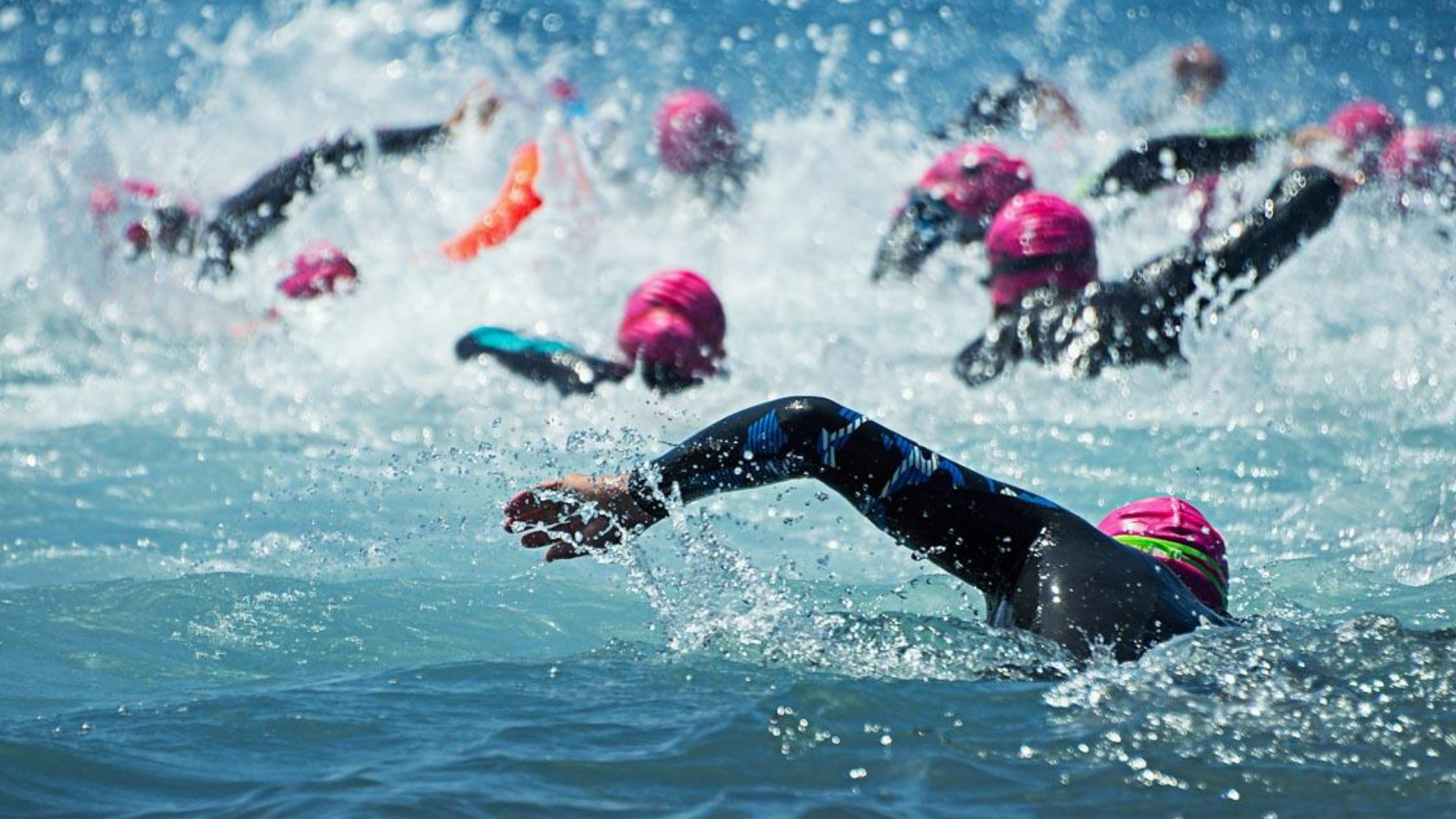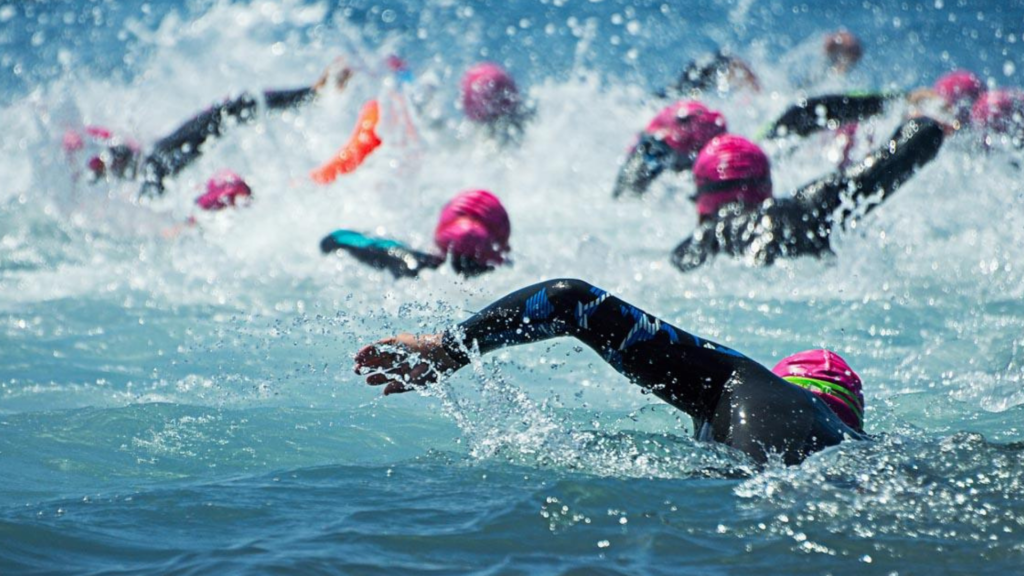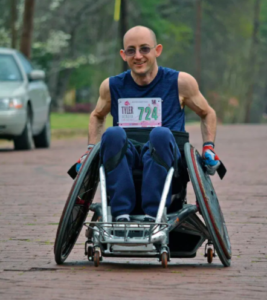
Pool Drills for a better transition to Open Water Swimming
- Post author:webadmin
- Post published:June 20, 2021
- Post category:FTR Blog / Swimming
- Post comments:0 Comments

Pool Drills for a better transition to Open Water Swimming
By. Jayden Chapman, USAT Certified Coach
For many triathletes the open water swim is the most daunting part of a race. There is no blue line to keep you on course, the water may be dark, and you know things live in it. If you don’t have access to open water during training, there are several drills that can help to prepare you to execute the swim well. There are also some mental tools to help lessen the anxiety you might experience on race day.
Sighting drills
There is no blue line to keep you swimming in a straight line in open water, so sighting is essential to avoid swimming off course and adding a lot of extra distance to your swim. Try placing a water bottle or a cone at the end of your lane to practice with.
Tarzan drill- start swimming front crawl and lift your eyes and head forward until your head is out of the water. Kick hard to keep your lower body from sinking too much. This allows you to see above the water to get your bearings while swimming.
Alligator eyes- start swimming front crawl, then push your chin forward until your eyes just clear the surface of the water. Allow the back to arch and kick hard to keep your hips high in the water. To breathe return to your regular head position and roll to the side to breathe like normal. Your visibility won’t be as good as with the Tarzan drill, but you can swim faster this way.
Rolling sight- start swimming front crawl, then every 4-5 strokes lift your eyes forward just above the surface of the water as you roll to the other side. This allows you to see above the water briefly to make sure you are still on course.
Eyes closed
Many races take place in murky water. In some cases you may not be able to see your own hands in the water. Try closing your eyes while your face is in the water and opening them only when you roll to breathe or practice your sighting.
Breathing drills
Controlling your breathing is key to staying calm in the water. You should always exhale when your face is in the water. This can be the first thing forgotten in cold, dark water. Exhaling clears your body of carbon dioxide and allows you to take in new oxygen. Breathing also helps your body to relax.
Bilateral breathing- Being able to breathe to either side prepares you to adjust to changing conditions. You may encounter the sun on one side, waves, and other swimmers that prevent you from breathing on your favored side. Try breathing every three strokes, or all on your weak side if you have a preference.
Try skipping a breath periodically, or breathing every 5 to 7 strokes. This helps to ensure that on race day when a wave or another swimmer prevents you from taking a breath, you know you’ll be just fine waiting another stroke or two to breathe.
Body position
Wetsuits are legal in water temperatures below 78 degrees. Triathlon wetsuits provide both warmth and buoyancy, and can offer a sense of safety and security in open water. If you plan to swim in a wetsuit on race day, it’s a very good idea to practice swimming in it before that day. (It’s also a good idea to practice taking it off quickly!) Other tools include buoyancy shorts and pull buoys, which mimic the body position of swimming in a wetsuit.
Crowded lane
If you’re used to swimming in a lane by yourself, try getting a group together and all swimming in the same direction at the same time.
Race Day
Swim in the water the day before the race if you have the opportunity. Warm up in the water on race morning. Look for things you can sight off of aside from the buoy- maybe a tall tree or building beyond the buoy.
Position yourself appropriately at the start. This may be toward the back or the sides if you are a newer swimmer, or if you want to avoid the more crowded front and center of the pack. Many races will have you seed yourself based on your predicted swim time.
Remember to exhale out of your nose underwater as you swim.
Kick hard as you approach the shore to warm up your legs before getting on your bike, and swim for as long as you can into the shore. You can swim faster than you can run through shallow water.
You made it! Have a great race!

Coach Jayden Chapman, USA Triathlon Coach
As an athlete I’ve been involved in triathlon since 2004. After an accident in 2012, I returned to the sport as a paratriathlete in 2015. My educational and professional background is in nutrition, with a Master of Science in Nutrition from Bastyr University, and a private nutrition practice specializing in endurance athletes and adaptive athletes since 2019. For ten years I taught karate, rock climbing, and Pilates. I went into the field of nutrition to support myself and others in pursuing health and athletic goals. Working with athletes from a nutrition perspective motivated me to pursue coaching certification through USA Triathlon. It is a joy to work with people to meet and exceed the goals they set for themselves. I look forward to hearing what your goals are and I would be excited to be part of that journey.



